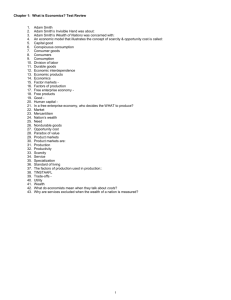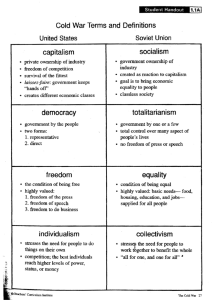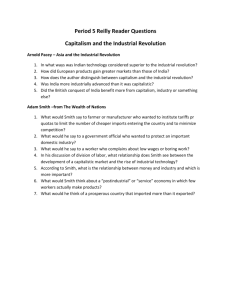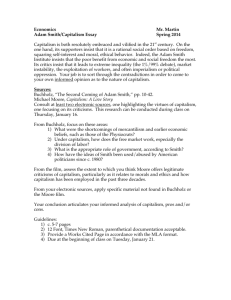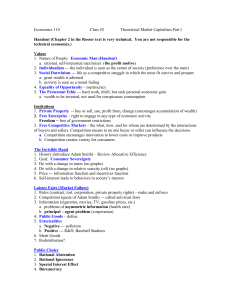Capitalism and Free Enterprise
advertisement
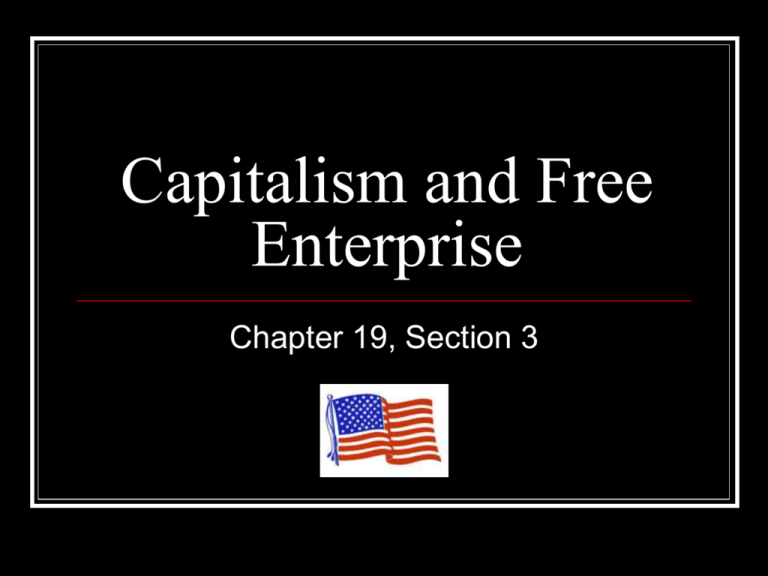
Capitalism and Free Enterprise Chapter 19, Section 3 Capitalism – The American Economic System (also called Free Enterprise) What are the benefits of capitalism and why has it spread to so many countries? Individuals own most, if not all, resources and control their use Capitalism has been the only economic system to continue economic growth for the 200 years since the Industrial Revolution. Where did the idea of capitalism come from? No one person invented it. It developed gradually from economic and political changes in medieval and early modern Europe over hundreds of years. Two important concepts laid the foundation for the market system that is at the heart of capitalism. a. People should work for economic gain b. Government should have limited role in the economy Adam Smith, “The Wealth of Nations” Scottish philosopher Adam Smith is the author of the 1776 book An Inquiry into the Nature and Causes of the Wealth of Nations, a classic of modern economics beloved especially by free market advocates. He began his academic career as a professor of logic and moral philosophy. Known as the Father of Modern Capitalism and Free Enterprise The Wealth of Nations Scientifically described the basic principles of economics for the first time Smith believed that individuals seeking profit, end up benefiting society as a whole. From the writings of Smith and others came the basic idea of “laissez-faire” economics. “The invisible hand” concept The invisible hand is a metaphor coined by the economist Adam Smith. In The Wealth of Nations and other writings, Smith demonstrated that, in a free market, an individual pursuing his own self-interest tends to also promote the good of his community as a whole through a principle that he called “the invisible hand”. He argued that each individual maximizing revenue for himself maximizes the total revenue of society as a whole, as this is identical with the sum total of individual revenues. Smith used the term 'invisible hand' only three times, but the metaphor later gained widespread use. Laissez-Faire Economics From a French term meaning “let alone”. Laissez-faire philosophy believes government should not interfere in the marketplace. The government’s role is strictly limited to those few actions needed to insure free competition in the marketplace. Laissez Faire in U.S. Economics The political side of laissez-faire held that the best government was the one that governed least. This view enjoyed its heyday during the industrial revolution of the late nineteenth century (though it did not preclude protective tariffs). Its last hurrah in the 1920s reflected the view that government had grown too large as a result of progressive regulatory expansion and wartime economic controls. Moreover, big business—once the progressives' whipping boy—had regained popular esteem through its war production success. Getting government off the back of business therefore became a primary goal of the Republican administrations of Warren Harding and Calvin Coolidge. This led to the Great Depression in 1929. Features of Capitalism Markets Economic Freedom Private Property Rights Competition The Profit Motive Voluntary Exchange Markets When you go to work, your labor is being sold in the factor market. When you go shopping, the goods and services you buy are being purchased in the product market. Markets are the places where the prices of goods and services are determined as exchange takes place. Markets do more than set prices. They are mechanisms that connect the different sectors of the economy. Economic Freedom Choice is a key element in the free enterprise system Consumers have the right to choose the products they buy Business have the right to choose the products they will produce and offer for sale Private Property Rights We have the freedom to own and use or dispose of our own property as we choose as long as we do not interfere with the rights of others. Competition Capitalism thrives on competition. Competition is the struggle that goes on between buyers and sellers to get the best products at the lowest prices. Competition between sellers keeps the costs of production low and the quality of goods high. Buyers compete among themselves to find the best products at the lowest prices. Why is competition so important? Competition rewards the most efficient producers. Competition forces the least efficient producers out of business. Competition makes for efficient production, higher quality products, and more satisfied consumers. The Profit Motive The driving force that encourages individuals and organizations to improve their material well being Profit=amount of $$ left over after all the costs of production have been paid. Motive=the desire to do better at a risk Voluntary Exchange The act of buyers and sellers freely and willingly engaging in market transactions. Both the buyer and the seller benefit. Productivity A measure of the amount of output produced by a given amount of inputs in a specific amount of time. Productivity goes up whenever more output can be produced with the same amount of input. In terms of labor, the same number of workers triple the number of TV’s they produce in a week. Output (productivity) has increased without an increase in input (labor). Specialization Takes place when people, businesses, regions, even countries concentrate on goods or services they can produce better than anyone else. The French have long been specialists in wine making. Since the 1980’s California wines have begun to rival the specialization of France. What are some products North Carolina specializes in? Division of Labor The breaking down of a job into separate, smaller tasks which are performed by different workers. A form of specialization that improves productivity. Human Capital Productivity tends to increase when businesses invest in human capital…the sum of the skills, abilities, and motivation of people. business investments in training, health care and employee motivation tend to increase the amount of production that takes place. Consumer Rights and Responsibilities To make good economic decisions, we need to be aware of our rights and responsibilities as consumers. “Caveat Emptor” Throughout most of history consumer rights could be summed up with this one Latin phrase meaning “Let the buyer beware”. Consumerism A movement to educate buyers about the purchases they make and to demand better and safer products from manufacturers that affect you personally. Laws which protect consumer rights Fair Packaging and Labeling Act Pure Food and Drug Act Consumer Bill of Rights John F. Kennedy had equated the rights of the ordinary American consumer with national interest. He gave the American consumer four basic rights: The Right to Safety - to be protected against the marketing of goods which are hazardous to health or life. The Right to Choose - to be assured, wherever possible, access to a variety of products and services at competitive prices: and in those industries where competition is not workable and Government regulation is substituted, an assurance of satisfactory quality and service at fair prices. The Right to Information - to be protected against fraudulent, deceitful or grossly misleading information, advertising, labeling, or other practices, and to be given the facts s/he needs to make an informed choice. The Right to be Heard - to be assured that consumer interests will receive full and sympathetic consideration in the formulation of Government policy, and fair and expeditious treatment in its administrative tribunals. The Right to Redress – obtain payment from manufacturers if their product causes financial or physical damage. Consumer Responsibilities Follow warranty directions Exhibit ethical behavior Uses of Income Disposable Income – the money a person has left after all the taxes on it have been paid. Usually people buy necessities out of this such as food, clothing and housing. Discretionary Income – money left over after buying necessities, used for satisfying wants such as luxuries or putting in a savings account. Decision Making All the steps in decision making involve an opportunity cost. You must decide if your purchase is worth what you have to give up to own it. Question One __________ can improve productivity. a. b. c. d. Trading with the foreign sector Cost-benefit analysis Government revenue Specialization Question Two Some of the characteristics of capitalism are __________. a. competition, profit, and government ownership of resources b. markets, government-set prices, and private property c. markets, private property, competition, and profits d. competition, profit, and production based on custom and tradition Question Three The author of The Wealth of Nations was __________. a. Alexander Hamilton b. Adam Smith c. Thomas Mann Randolph d. Thomas Jefferson Question Four In laissez-faire economics, the government's role is . .. a. strictly limited to those few actions needed to ensure free competition in the marketplace b. to tell producers what and how much to produce c. to set prices for all goods and services produced d. to completely refrain from any involvement in the marketplace Question Five A group that provides information about local businesses and warns consumers about dishonest business practices is the a. Consumer Rights Council b. Consumer's Voice c. Commission on Consumer Safety d. Better Business Bureau Question Six The money income that a person has left after taxes is called __________. a. b. c. d. discretionary income disposable income ethical income savings income Question Seven The factors of production are __________. a. natural resources, labor, capital, and money b. natural resources, capital, goods, and services c. natural resources, labor, capital, and entrepreneurs d. natural resources, money, labor, and entrepreneurs Question Eight Capital goods are __________. a. b. c. d. used to make other products used to satisfy consumer wants directly money, in all of its forms mineral deposits and fossil fuels Question Nine Gross Domestic Product is __________. a. the total value of all goods and services produced in a single year b. the total value of all final goods and services produced in a single year c. the total value of all capital goods produced in a single year d. the total value of all labor produced in a single year Question Ten Consumers earn their income in ________. a. b. c. d. the consumer sector the product market factor markets the business sector Question Eleven What is the “invisible hand” described by Adam Smith in “The Wealth of Nations”? a. b. c. d. Self-interest of individuals Business guidelines Economic benefits Free enterprise system Question Twelve What is another name for a Market Economy? a. b. c. d. Communism and free markets Capitalism and free enterprise Fascism and military control Socialism and government controls

